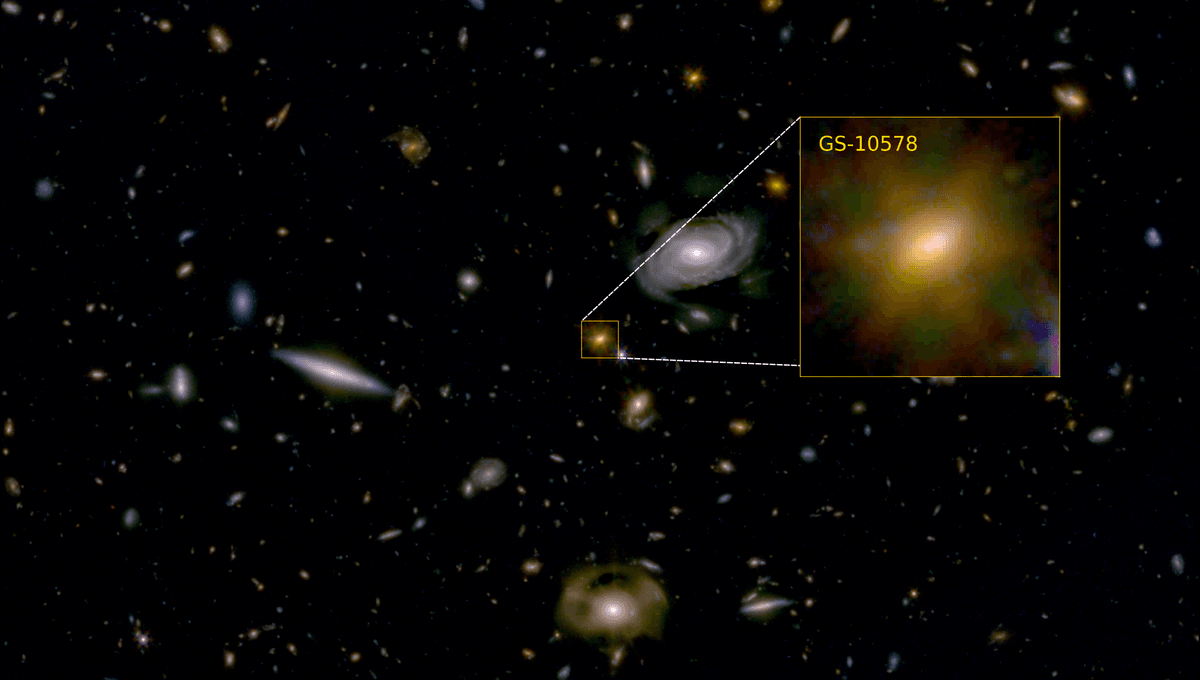
A galaxy seen by the JWST has confirmed the suspicion that some supermassive black holes can kill their home galaxy. The galaxy in question is around the mass of the Milky Way, but is set on a very different path. You might expect such an inside job murder to occur by the black hole consuming so much gas there is not enough left over to form stars, but it turns out there is another way.
Two billion years old is far too young for a galaxy to die, barely a child by cosmological standards. Small galaxies may end their lives at that age after being eaten by larger ones, but a big galaxy with only a few billion years on the clock should be able to look forward to a productive life.
That’s not the case for GS-10578, however. It will keep on shining for a very long time, thanks to a brief but intense period of star formation a little over a billion years after the Big Bang. Nevertheless, it is what astronomers consider mostly dead, unable to form new stars – and the blame lies with its supermassive black hole (SMBH).
Galaxies die through having insufficient gas to form stars, although the reasons for this vary. Sometimes galaxies’ star formation pauses with the potential to restart, which astronomers refer to as being quenched.
“Based on earlier observations, we knew this galaxy was in a quenched state: it’s not forming many stars given its size, and we expect there is a link between the black hole and the end of star formation,” said Dr Francesco D’Eugenio from Cambridge University in a statement. “However, until Webb, we haven’t been able to study this galaxy in enough detail to confirm that link, and we haven’t known whether this quenched state is temporary or permanent.”
To non-astronomers, it is easy to imagine a giant black hole at a galaxy’s heart sucking all the gas inwards, like some sort of ravenous cosmic tapeworm which grows spectacularly while leaving no food for star formation. However, even the hungriest black holes we have observed are incapable of this, particularly in a galaxy like GS-10578 that has an estimated mass of 200 billion Suns, 80 percent of which is already made up of stars.
Instead, the killer black hole is more like a case of food poisoning, causing the galaxy to vomit gas by accelerating material to 1,000 kilometers per second (2.2 million mph), around the galactic escape velocity. Black holes creating winds of ionized gas that sweep material from a galaxy are a common feature, but we’ve previously only observed cases that slowed down star formation, not killing it entirely.
However, the JWST revealed GS-10578’s black hole is working double-time. In addition to the winds of hot but thin ionized gas created, the SMBH is expelling much denser neutral material at lower temperatures. This greater density has far more effect on the host galaxy’s mass balance but is too cold to be seen directly. The only reason we know what is happening is because the JWST could see the silhouette created as clouds of dark gas block out more distant galaxies.
The quantity of gas calculated from the JWST’s observations is sufficient to explain why GS-10578 stopped forming stars.
“We found the culprit,” said D’Eugenio. “The black hole is killing this galaxy and keeping it dormant, by cutting off the source of ‘food’ the galaxy needs to form new stars.”
However, there is more to this event than proof that black holes can kill a host galaxy this way. GS-10578 is so distant we are seeing it as it was 2 billion years after the Big Bang, and that means it reached a mass like the Milky Way’s unusually fast. Given its abundance of stars, it also means that star formation was rapid until quite recently – the death by black hole has been fast and lethal, starting about 400 million years ago.
On the other hand, GS-10578 shows none of the signs models predicted for galaxies killed in this way. Its shape and the motion of its stars are conventional, rather than being destroyed by turbulence as we anticipated.
Galactic corpses are common in the local universe, made up of huge galaxies whose small stars still shine, but with very few of the higher mass stars that live and die much faster. However, just as it is hard to identify the culprit in a cold case, humans showed up far too late to observe the cause of death directly.
Now that we have witnessed a galactic murder in action, we know one way they can occur, but that doesn’t prove every death has the same cause. An alternative theory holds that explosions from numerous young hot stars can expel a galaxy’s gas with similar consequences, and we don’t yet know if some of the victims we see died this way,.
GS-10578 was thought to belong to a class of galaxies known as blue nuggets because they are very densely packed and still contain some young stars. However, it turns out to be a red nugget instead – still very dense, but with no new star formation.
The study is published in the journal Nature Astronomy.
Source Link: A Black Hole Is Starving Its Galaxy To Death, But Not How You Think